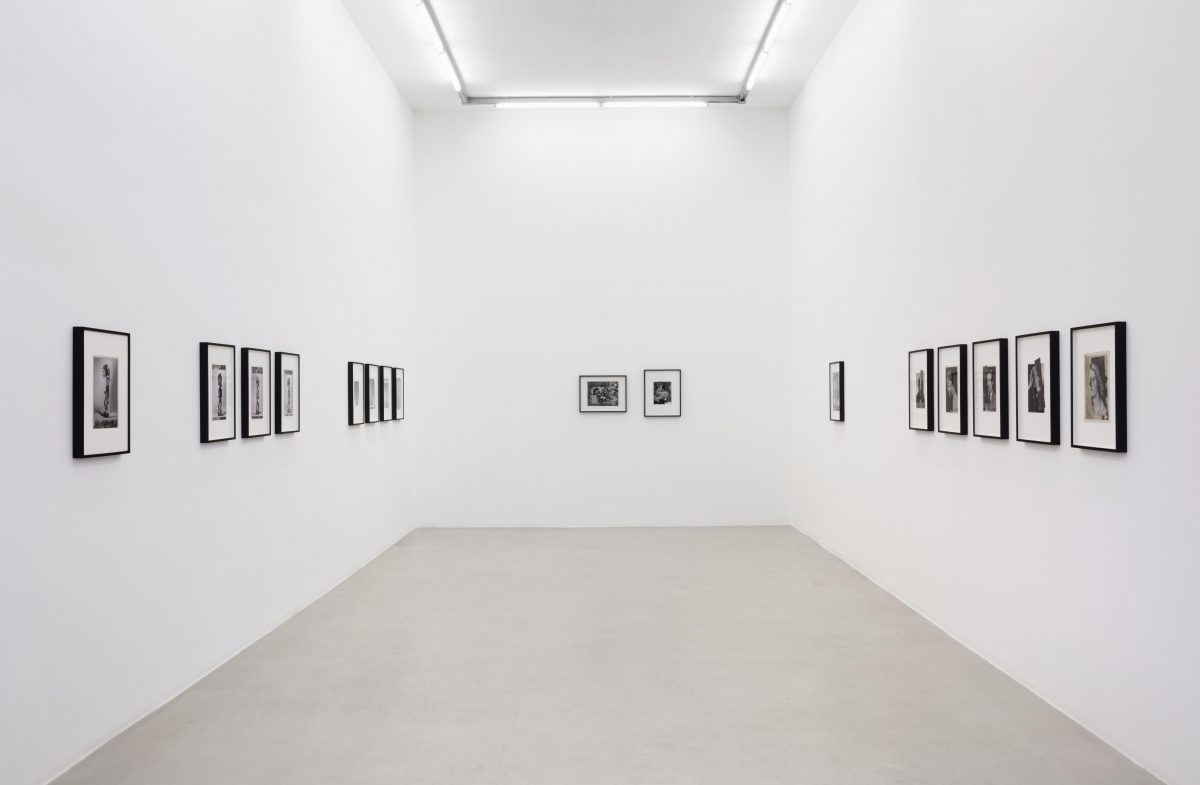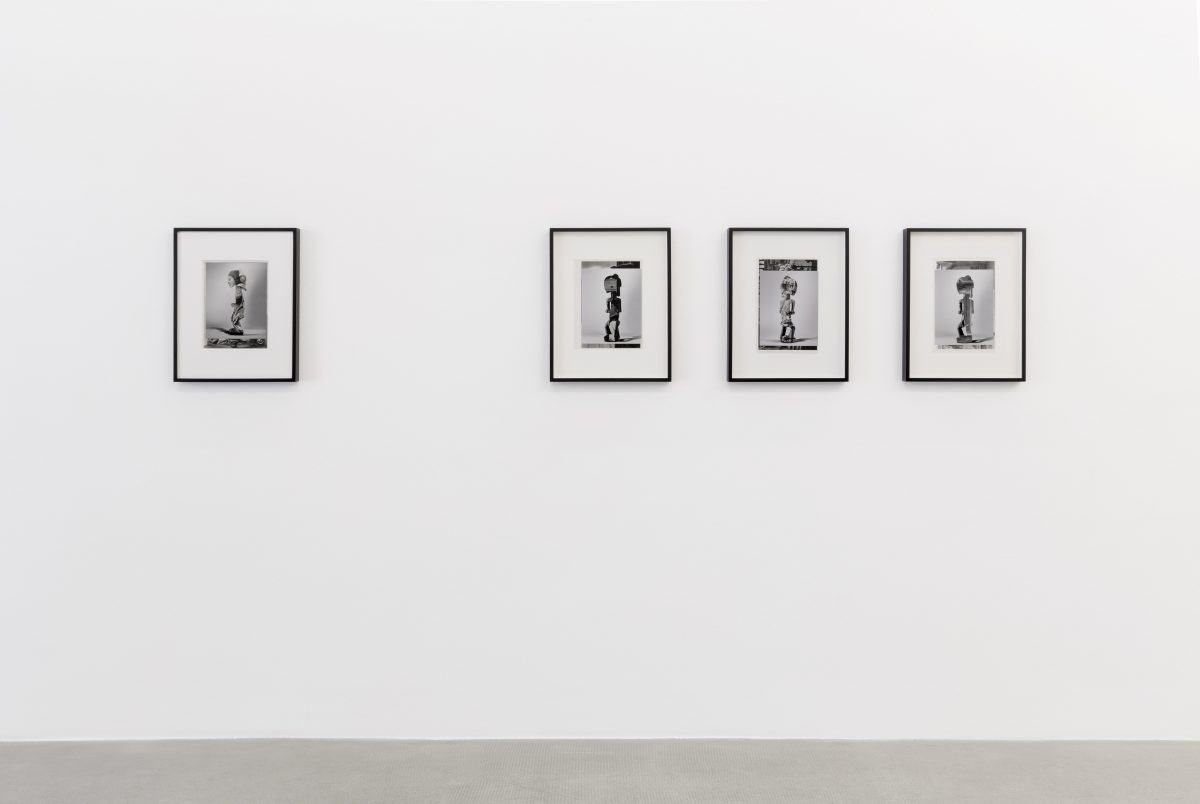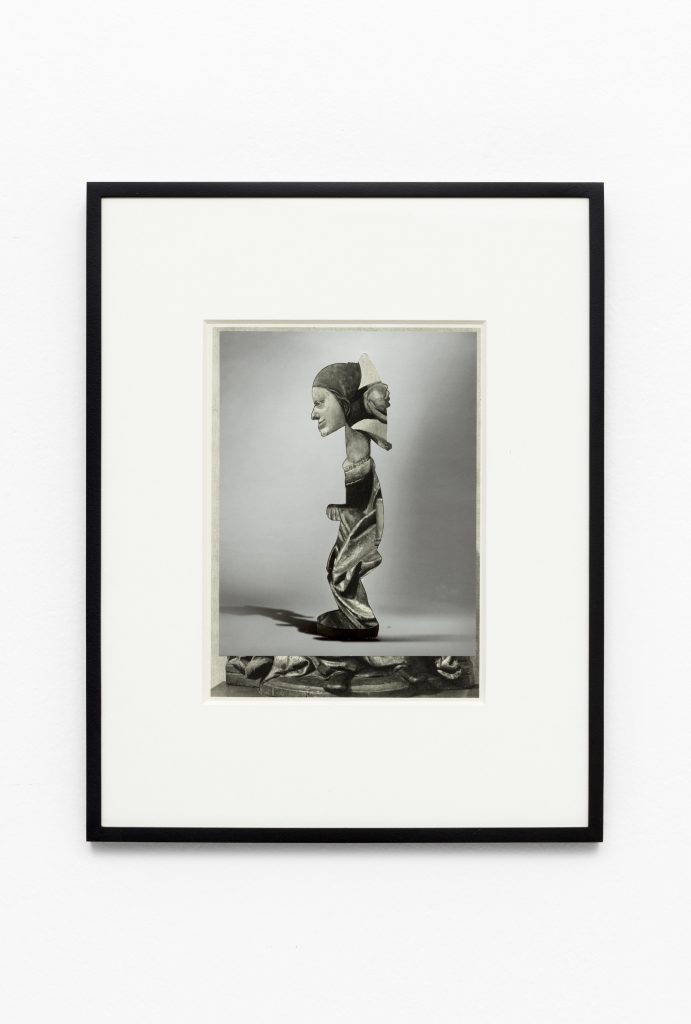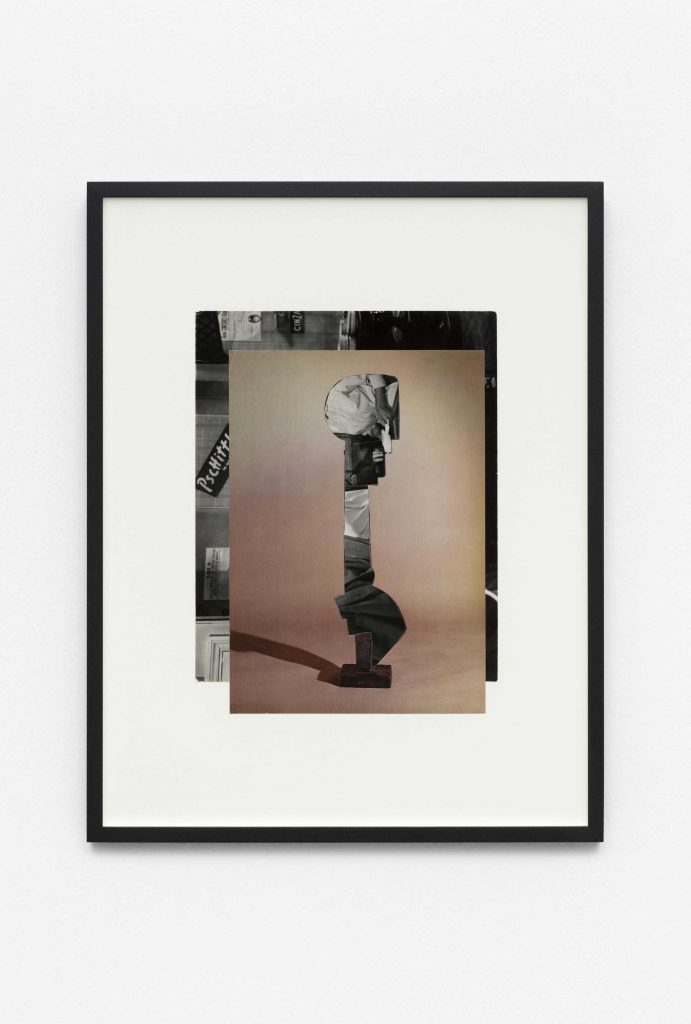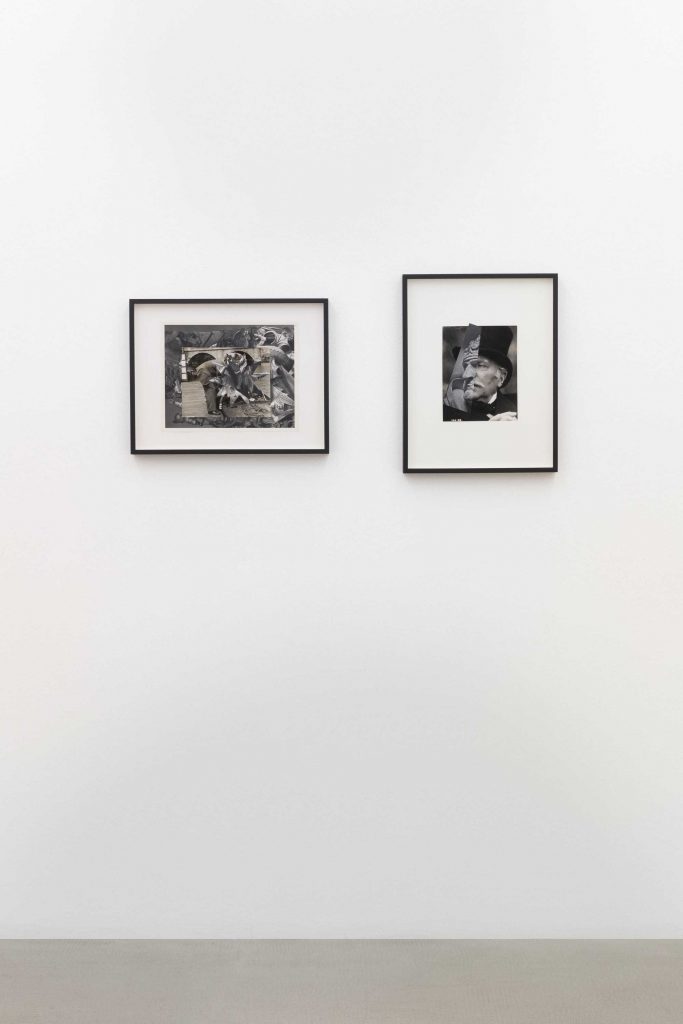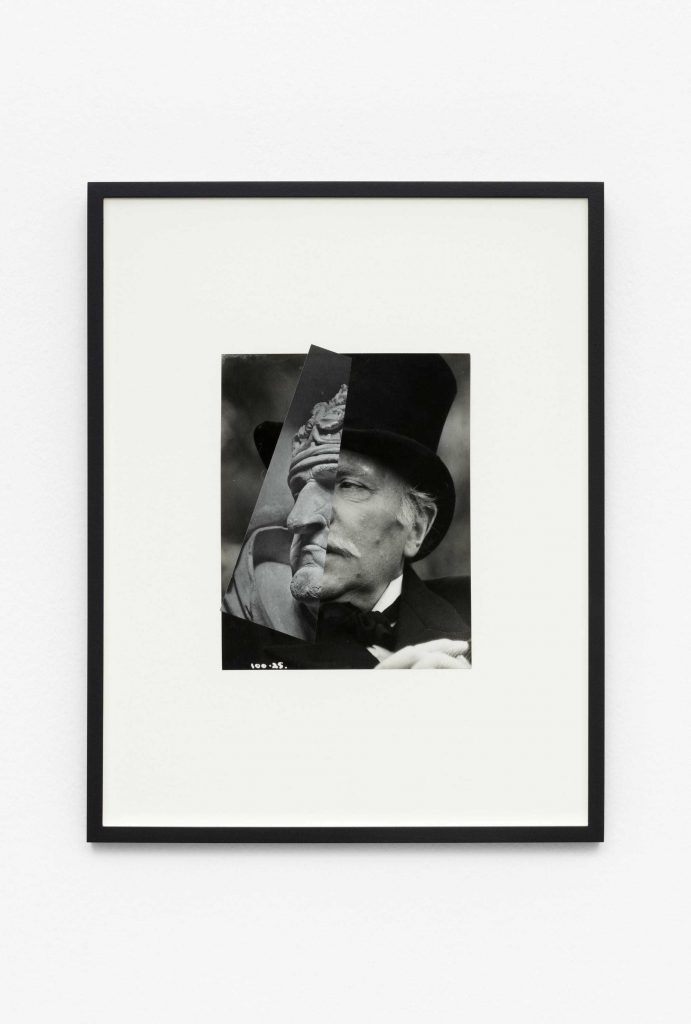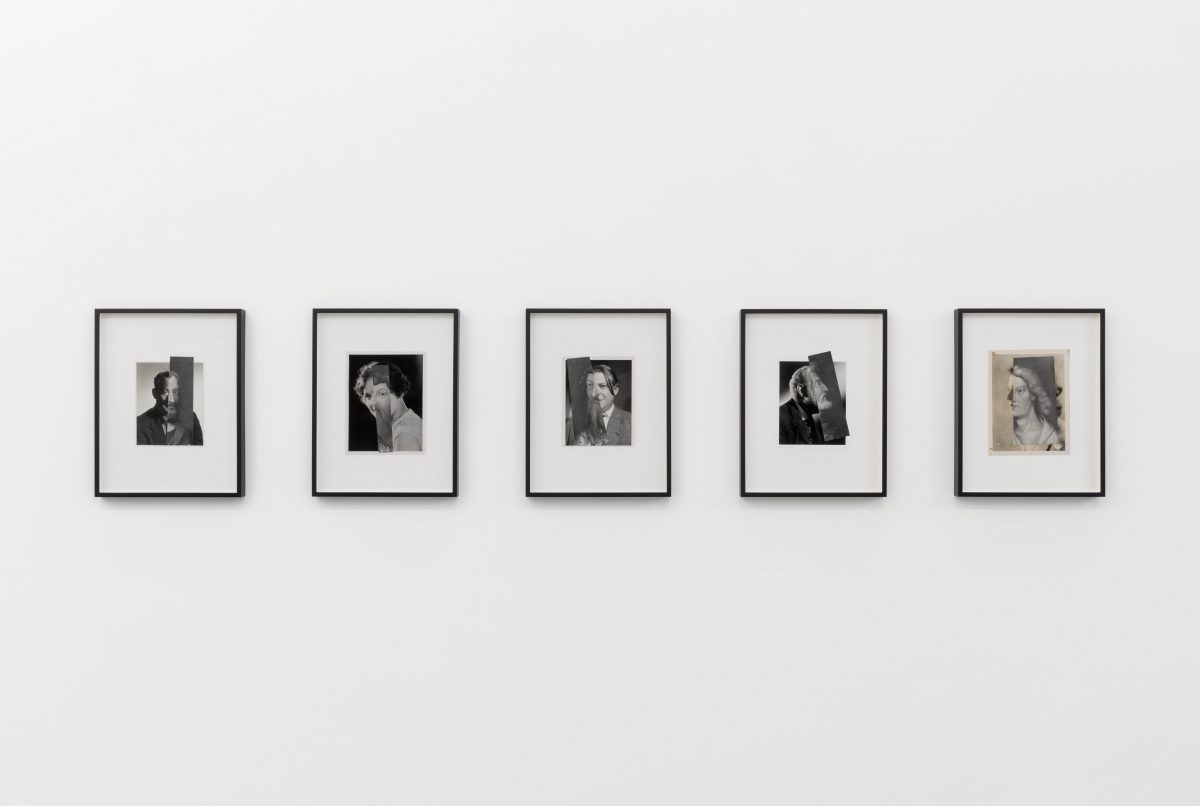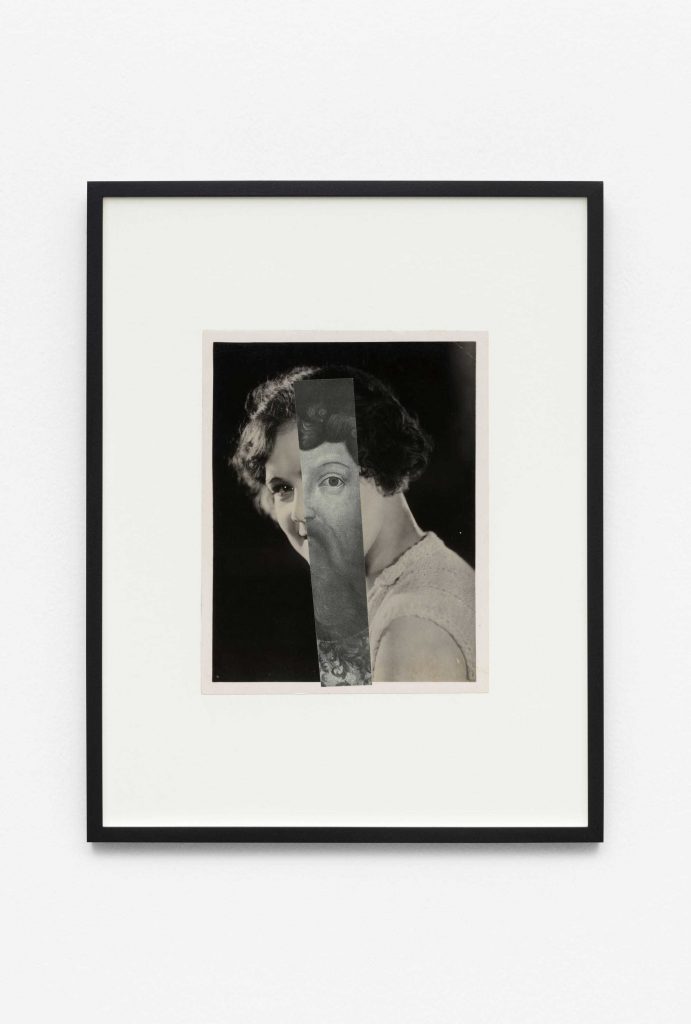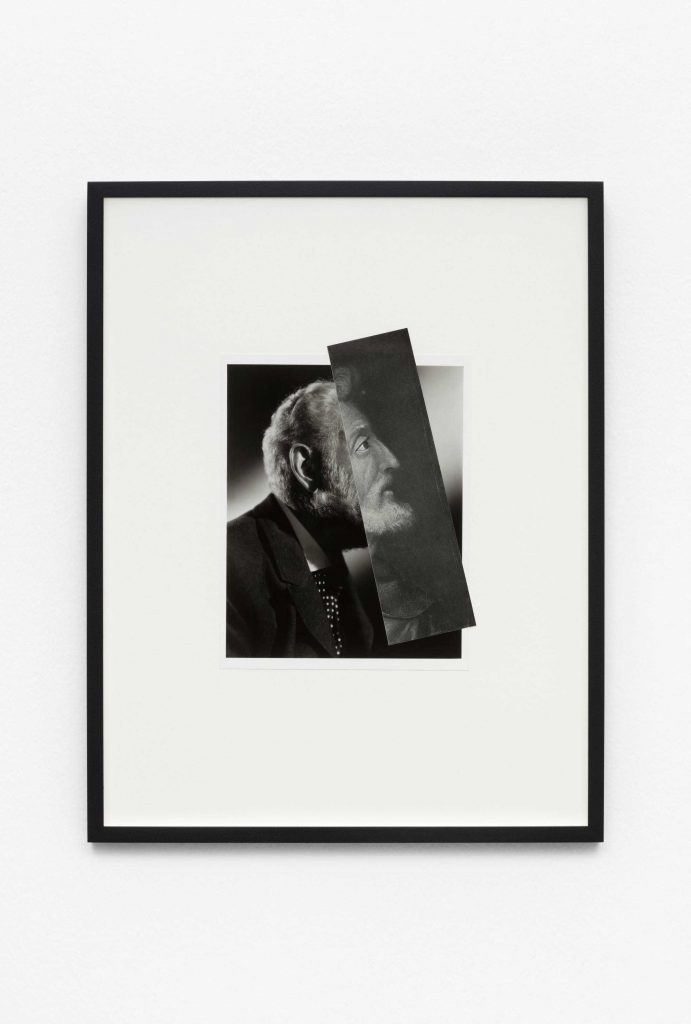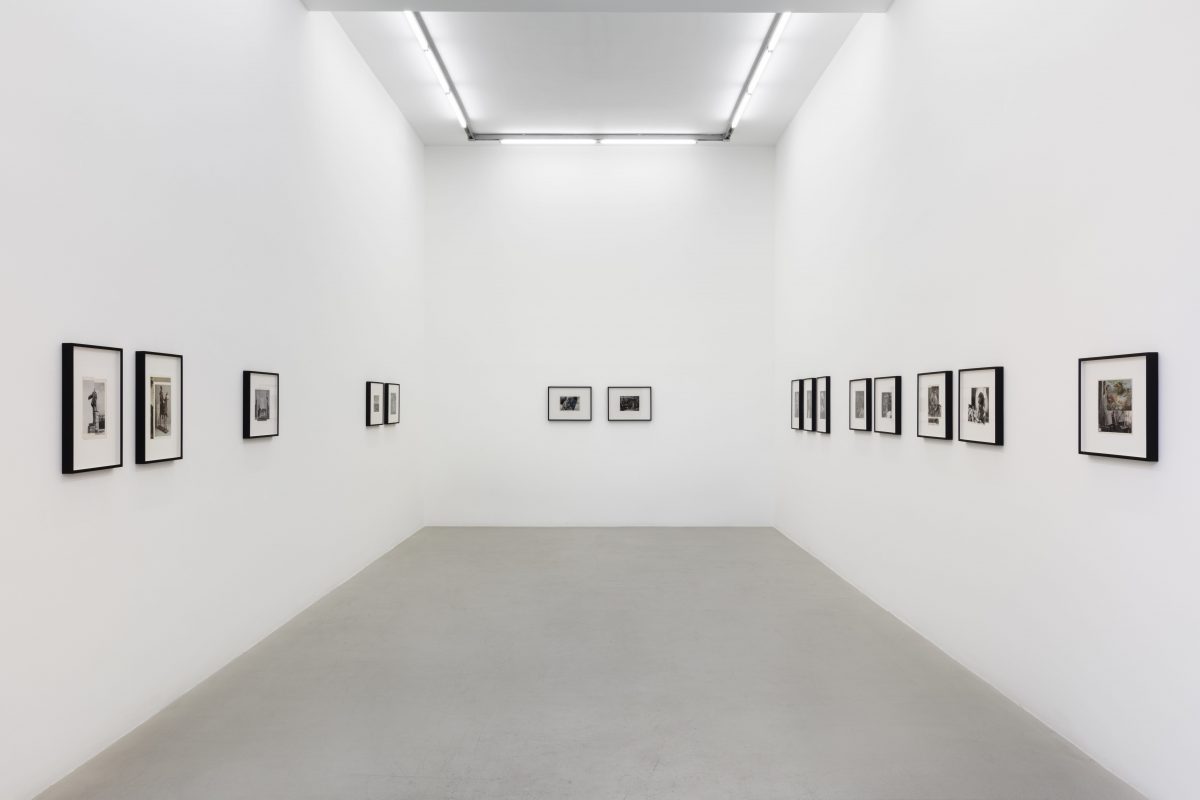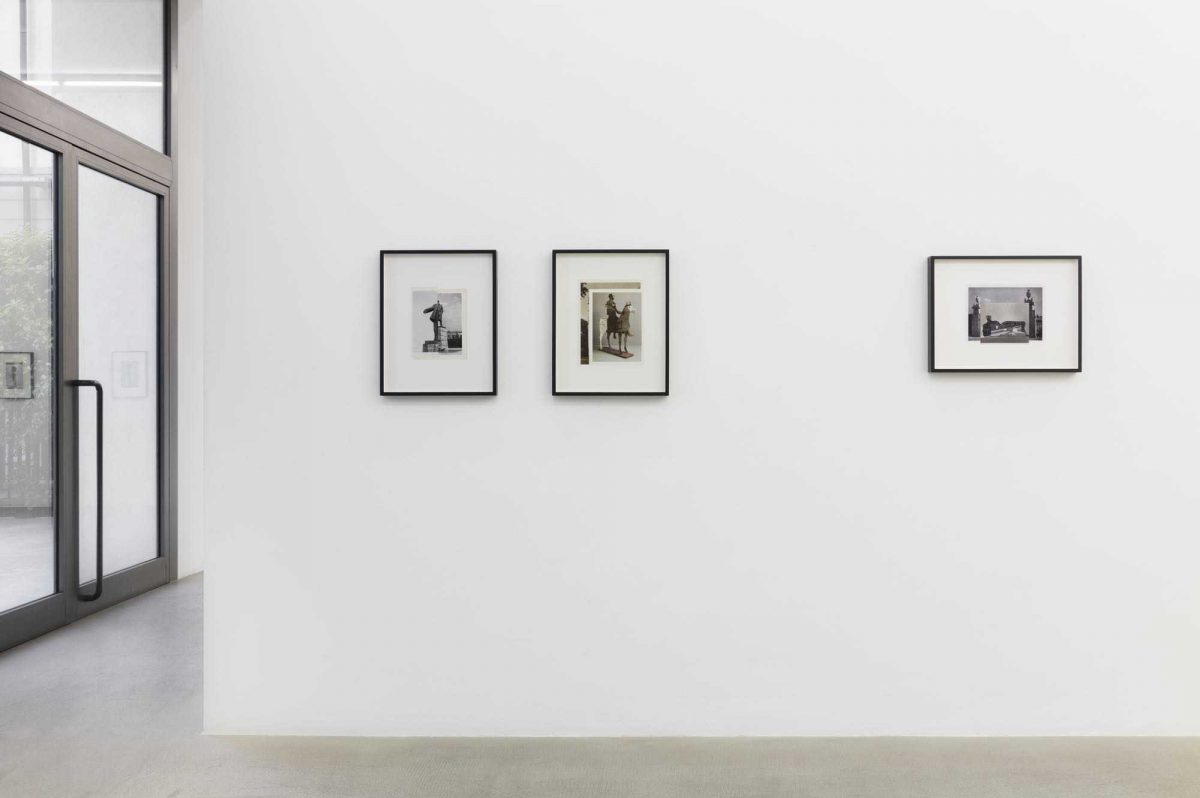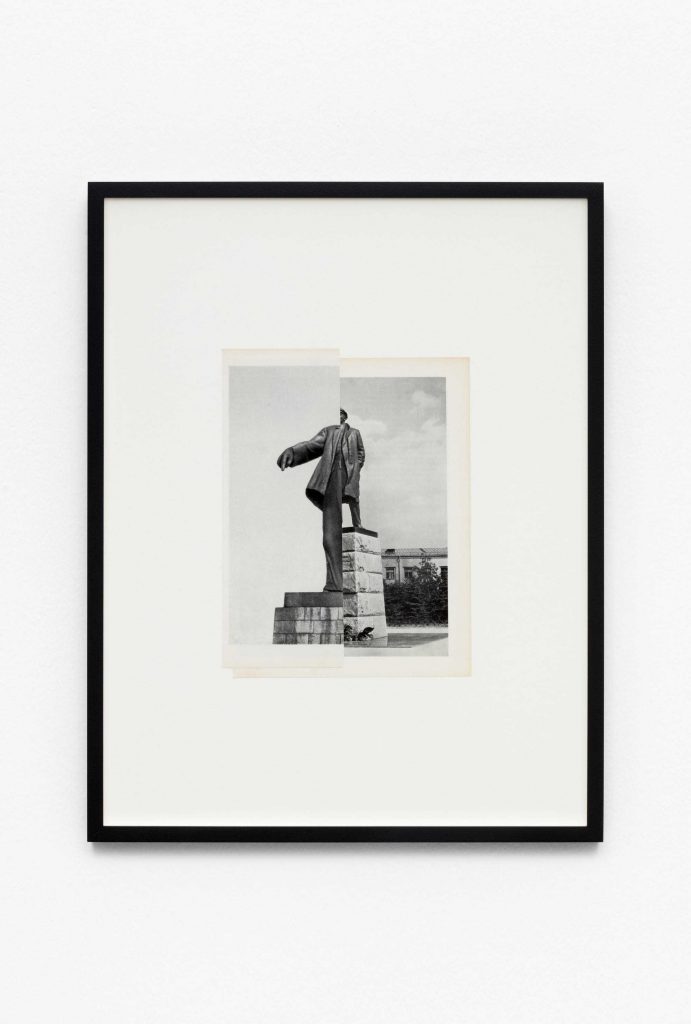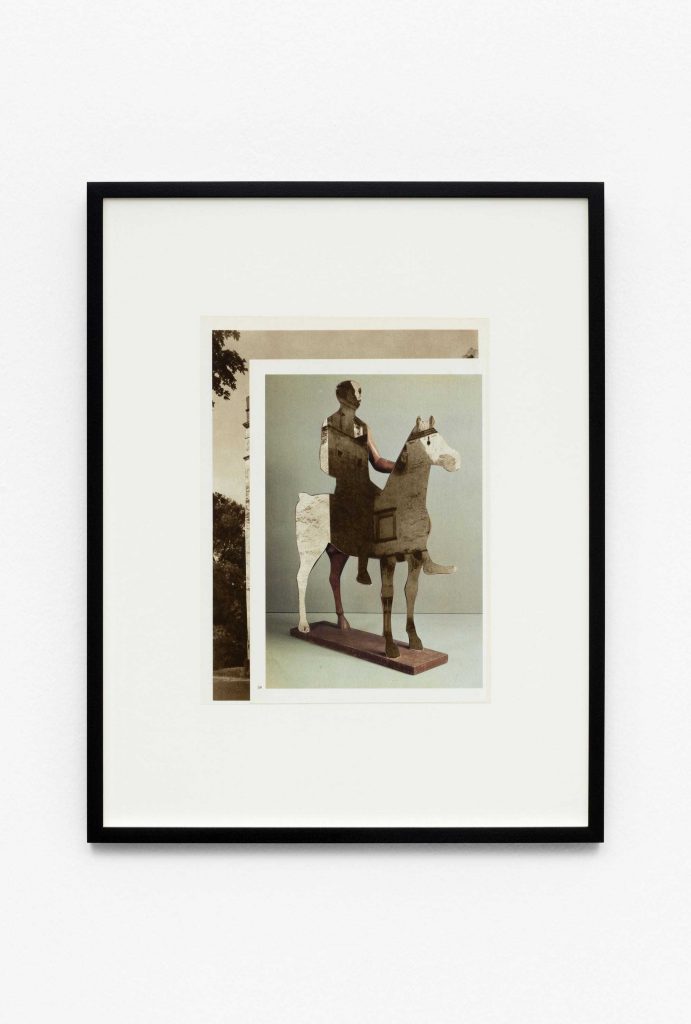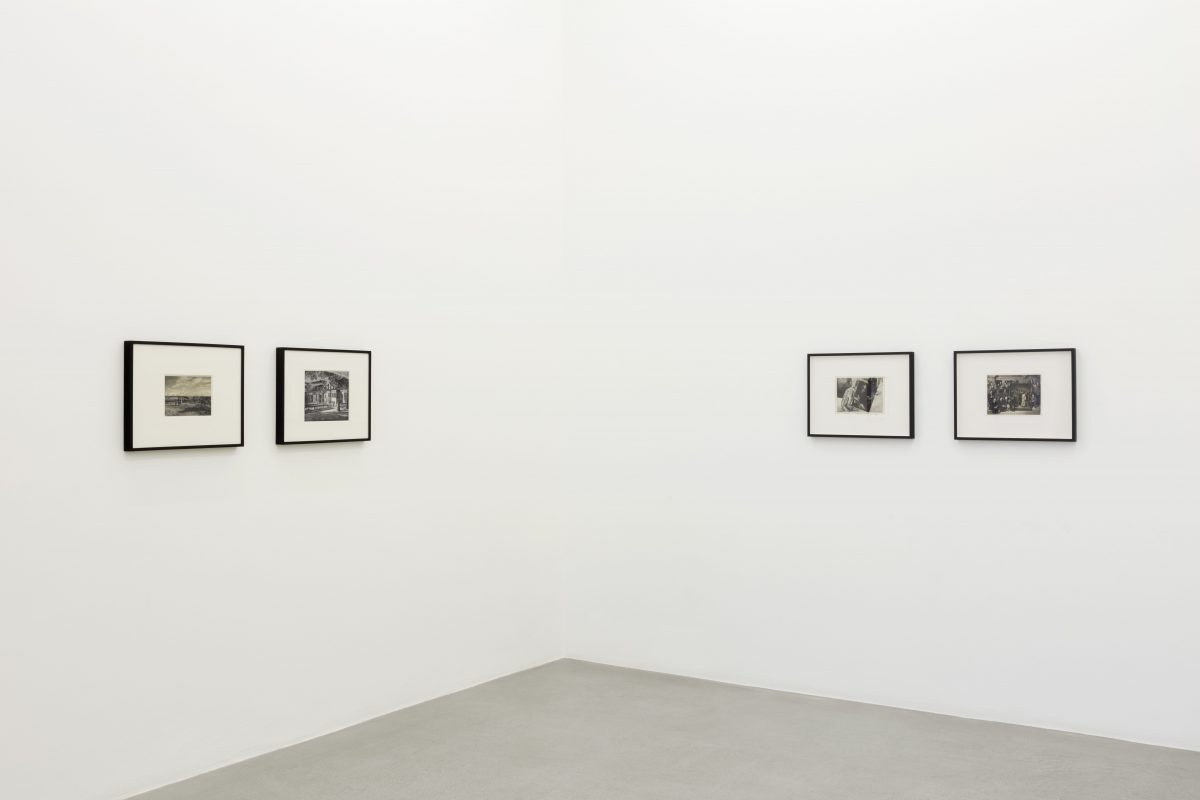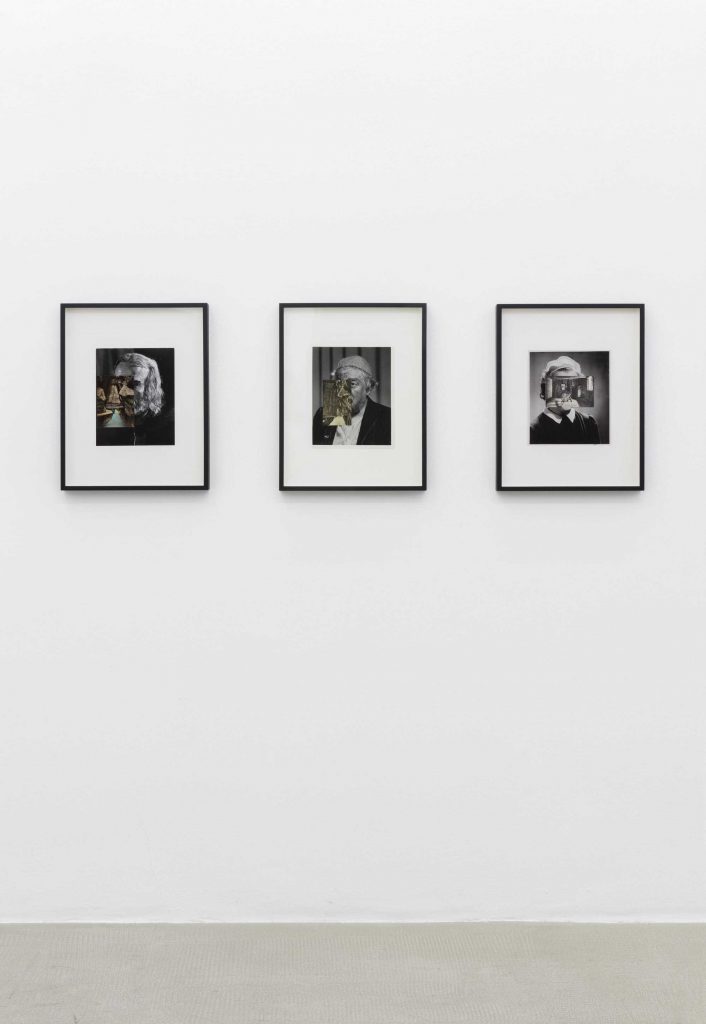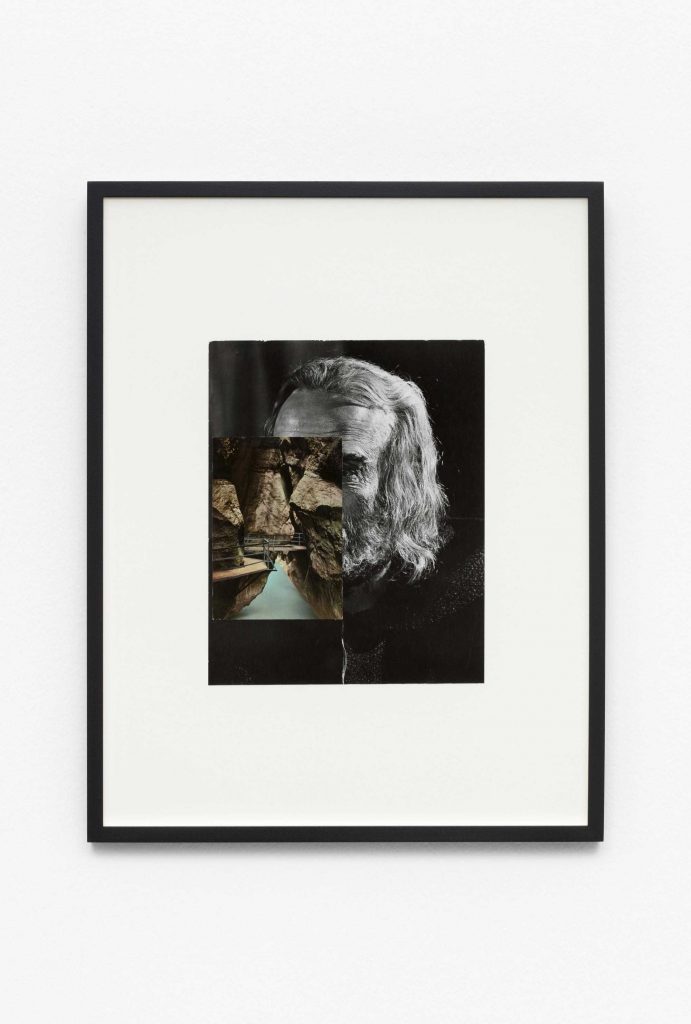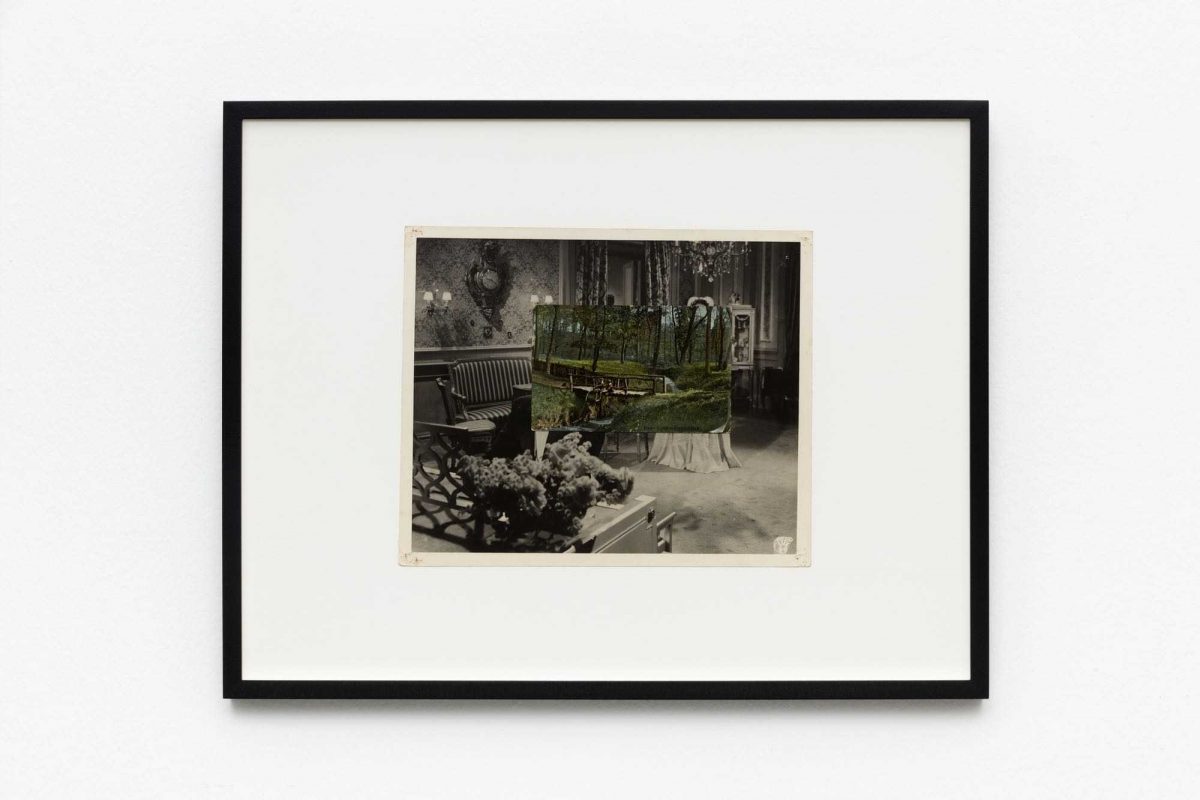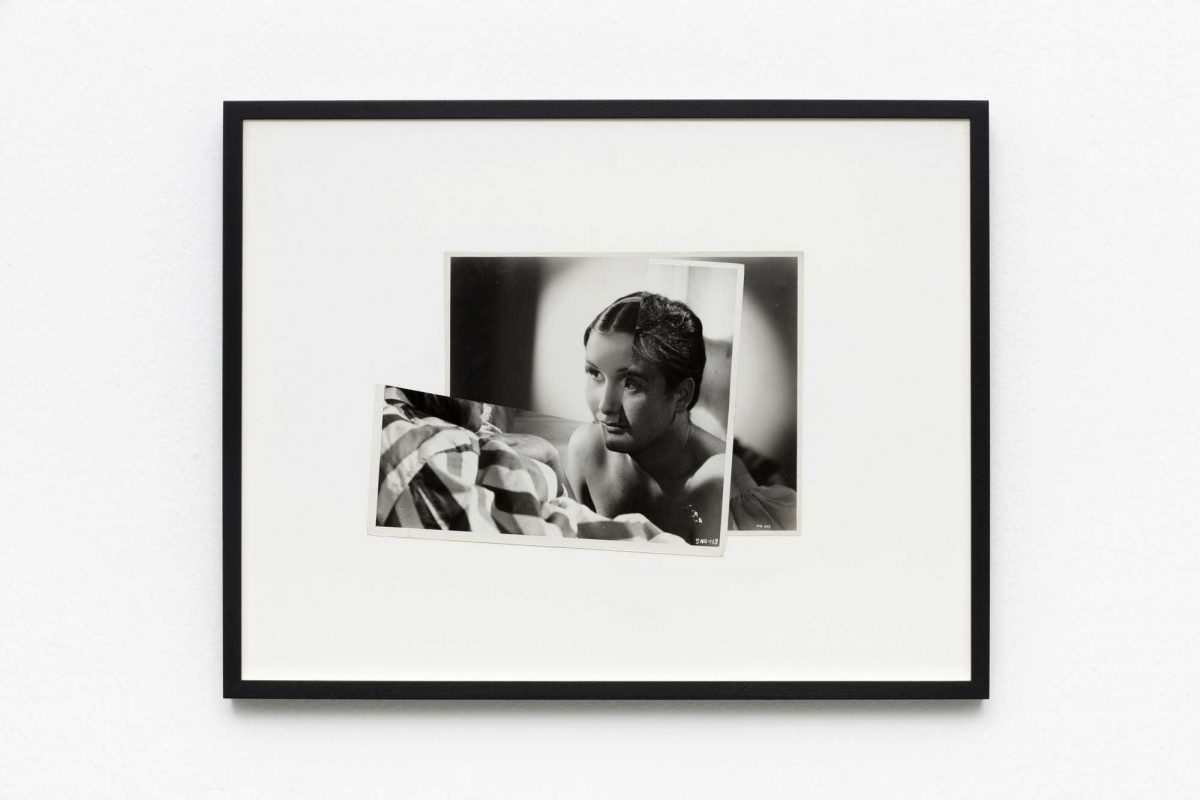
- This event has passed.
kaufmann repetto is pleased to present Cross, English artist John Stezaker’s first solo exhibition with the gallery. A cult figure in post-war British art, through a range of techniques made up of sparse and rigorous actions, Stezaker re-examines the role of the photographic image in contemporary culture, challenging its unreliability as a document of reality or a stronghold of memory, investigating the drift of its meanings. In his Chalk Farm studio in London, the archive of images collected and catalogued obsessively by the artist—guided by the daemon of a fundamental process in his production: that of fascination1—are implemented as genuine readymades, transformed through juxtaposition, re-framing, and other editing tools to form small to medium-sized collages, seductive yet on the verge of the disconcerting.
The collage is a workshop of grafting, a space in which the selection and layering of images is not structured on the basis of the logics of synthesis or hybridization, but by sudden and precise syntactic shifts that imply the idea of a constant separation that is being bridged. Stezaker thus positions his subjects in the space defined by notions of the “liminal”, exploiting the qualities and elements of antagonistic natures—male/female, urban/pastoral, nature/culture, landscape/portrait—which make them at the same time a metaphor for union and disaggregation, of a marriage and its consequent betrayal: “they look like fusions but are more like mutual cancellations.2”
The material at the basis of Stezaker’s collages has already lived previous lives and experienced the physical consequences of this circulation: images, photographs are ultimately objects and are thus destined to suffer the fate of all material things. What Stezaker shows us has passed before other gazes before reaching his own—despite the fact that those photographs have never been considered as they are now, as a consequence of their having been transformed into works of art. Through his combinations and graftings, Stezaker leads an investigation into these new figures, detournements made up of correspondences that lull the mind into a regressive game, one seamlessly revolving around the reconstruction of a dominant image, and one which continually offsets the decoding process through the fundamental ambiguity intrinsic to the image.
In the first room, the series of collages titled Untitled (Africa) (2016-19) depict silhouettes reminiscent of the modernization of European art, protracted through the subjugation of the history of African artistic production and the inclusion of its styles through a form of cultural proto-gentrification. Their perimeter is drawn into an interplay of visual and semiotic crossovers with the vaults of gothic heritage and the profile of what appears to be a Virgin Mary in painted wood, they become more grim and, even, more horrifying.
In the collages from the series Gothic Portrait (2019), publicity portraits of the ’50s and ’60s intersect with pictorial subjects of European gothic religious portraiture, creating images that are perturbing in their incapacity to adhere to the expectations of the viewer in terms of a given gender or age, but also for the formal mismatches that stage the collapse of the timeline within which these new images exist.
In Betrayal (in pinewood) (2010), the alternation of registers of representation— sacred and profane, epic and everyday—come together to form a single image with slippery edges in which both sides blindly take part in a disjointed narrative.
Cross (2019), the film after which the exhibition is titled and which concludes the exhibition itinerary in ideal terms, shows the simultaneously liquid and static behavior of architecture: postcard images of the interiors of gothic cathedrals, and reproduced at the speed of 24 frames per second, transforming the sculpted stone into something flesh-like, biological tissue in constant decay, regeneration and transformation, all anchored around a center, a vanishing point that intermittently appears before the eyes of the viewer: a cross that stands out in the middle of a nave—the original act, the intersection of two lines, a cut that marks individual spaces yet spaces that fit into one another.
John Stezaker (b. 1949, Worcester, UK) lives and works in London, UK. He studied at the Slade School of Fine Art in London in the 1960s, and has since taught at Central Saint Martins School of Art, Goldsmiths College and the Royal College of Art. His solo exhibitions include John Stezaker: Lost World at the City Gallery of Wellington, New Zealand (2017); the Tel Aviv Museum of Art, Israel (2013); and the Whitechapel Gallery, London (2011), which then travelled to MUDAM in Luxembourg, also in 2011. His work has been exhibited in many group exhibitions internationally: the 19th Biennale of Sydney, Australia (2014); the New Museum of Contemporary Art, New York (2008); the Tate Triennial, London (2006); and the 40th Venice Biennale in 1982. Stezaker’s work is held in museum and public collections around the world, including the Museum of Modern Art, New York; the Tate Modern, London; and the Los Angeles County Museum of Art. John Stezaker: Portrait will be on view through 1st September 2019 at the National Portrait Gallery in London.
1° “I’m dedicated to fascination–to image fascination, a fascination for the point at which the image becomes self-enclosed and autonomous. It does so through a series of processes of disjunction… I’m very much a follower of Maurice Blanchot’s ideas when it comes to image and fascination; he sees it as a necessary series of deaths that the image has to go through to become visible and disconnected from its ordinary referent.” “Demand the impossible: Interview with John Stezaker by Michael Bracewell”, frieze, March 2005, pp. 92-93.
2° From an email conversation with the artist.
kaufmann repetto è lieta di presentare Cross, la prima mostra personale con la galleria dell’artista inglese John Stezaker.
Figura di culto della produzione artistica del dopoguerra nel Regno Unito, Stezaker, mediante uno strumentario di azioni scarne e rigorose, riesamina il ruolo dell’immagine nella cultura contemporanea, la sua inaffidabilità nel costituirsi come documento del vero e custode della memoria, investigandone la deriva dei suoi significati. Nello studio di Chalk Farm a Londra, l’archivio d’immagini raccolte e catalogate ossessivamente dall’artista – guidato dal demone di un processo fondamentale nella sua produzione, la fascinazione1 – e utilizzate come discreti Readymade, è trasformato mediante la giustapposizione, ricontestualizzazione e altri strumenti di editing, in collage di piccolo e medio formato, seducenti e ai limiti del perturbante.
Il collage è un laboratorio d’innesti, luogo dove la selezione e stratificazione delle immagini non è strutturata secondo logiche di sintesi, ma da repentini e precisi spostamenti sintattici che implicano l’idea di una costante separazione che viene unita. Stezaker colloca quindi i suoi soggetti nello spazio definito dal concetto di “liminale”, sfruttando qualità e elementi di natura antagonista – maschile/femminile, urbano/pastorale, natura/cultura, paesaggio/ritratto – che li rendono in egual modo metafora dell’unione e dello sgretolamento, di un matrimonio e del conseguente tradimento: “assomigliano a fusioni, in realtà sono più mutuali cancellazioni.2”
Il materiale alla base dei collage di Stezaker ha già vissuto vite precedenti, sopportato conseguenze fisiche: un’immagine, una fotografia, sono pur sempre oggetti e soffrono il destino di tutte le cose materiali. Ciò che egli ci mostra è passato attraverso altri sguardi prima di essere arrivato al suo – nonostante ciò quelle foto non sono mai state guardate come lo sono ora, anche in conseguenza del loro essere state trasformate in opere d’arte. Stezaker induce, attraverso le sue combinazioni e i suoi innesti, a indagare le nuove figure, detournement fatti di corrispondenze che seducono la mente in un gioco regressivo di ricostruzione di un’immagine dominante che rimanda continuamente il processo di decodificazione, a causa della fondamentale ambiguità che ogni immagine porta con sé.
Nella prima stanza, la serie di collage Untitled (Africa) (2016-19), mostrano silhouette che riportano la mente alla modernizzazione dell’arte europea, protratta attraverso il soggiogamento della storia della produzione artistica africana e l’inclusione dei suoi stilemi in una forma di proto-gentrificazione culturale. Il loro perimetro va a ricongiungersi in un gioco d’incroci visivi e semiotici con le volte di un panneggio gotico e il profilo di quella che appare come una madonna in legno dipinto, diventata ancor più arcigna e orrorifica.
Poco più avanti, nei collage della serie Gothic Portrait (2019) ritratti di scena degli anni ‘50 e ‘60 s’intersecano con soggetti pittorici della ritrattistica religiosa gotica europea, creando immagini perturbanti nella loro incapacità di aderire alle aspettative dello spettatore connesse a un determinato genere o età, ma anche per le disgiunzioni formali che inscenano un collasso della scala temporale all’interno del quale queste nuove immagini esistono.
In Betrayal (in pinewood) (2010) l’alternanza di registri di rappresentazione – sacro e profano, epico e quotidiano – s’incrociano in una singola immagine dai bordi scivolosi dove entrambe le parti prendono parte ciecamente a una narrazione sconnessa.
Cross (2019), il film che da il titolo alla mostra e che conclude idealmente il percorso espositivo, mostra il comportamento contemporaneamente liquido e statico dell’architettura: immagini di cartoline di interni di cattedrali gotiche, riprodotte alla velocità di un ventiquattresimo di secondo, trasformano la pietra scolpita in carne, tessuto biologico in continuo decadimento, rigenerazione e trasformazione, ancorata attorno a un centro, un punto di fuga che a intermittenza si mostra agli occhi dello spettatore: una croce che si staglia al centro di una navata – un atto originario, l’intersezione di due linee, un taglio che delimita spazi contraddistinti che combaciano tra di loro.
John Stezaker (1949, Worcester, Regno Unito) vive e lavora a Londra. In seguito ad aver completato gli studi presso la Slade School of Fine Art, Londra, dagli anni Sessanta Stezaker insegna presso la Central Saint Martins School of Art, il Goldsmiths College e il Royal College of Art. Le sue mostre personali recenti includono John Stezaker: Lost World presso il City Gallery of Wellington, Nuova Zelanda (2017); Tel Aviv Museum of Art, Israele (2013); e una mostra itinerante presso Whitechapel Gallery, Londra (2011), e MUDAM, Lussemburgo (2011). Il lavoro di Stezaker è stato incluso in mostre collettive quali la 19° Biennale di Sydney, Austalia (2014); New Museum of Contemporary Art, New York (2008); Tate Triennial, Londra (2006); e 40° Biennale di Venezia (1982). Il lavoro di Stezaker è incluso in collezioni pubbliche quali il Museum of Modern Art, New York; la Tate Modern, Londra; e il Los Angeles County Museum of Art. La mostra personale John Stezaker: Portrait è attualmente in corso presso la National Portrait Gallery, Londra, fino al 1 settembre.
1° “Mi dedico alla fascinazione – alla fascinazione dell’immagine, una fascinazione per il punto nel quale l’immagine diventa autonoma e racchiusa in se stessa. Questo avviene attraverso una serie di processi di disgiunzione… Sono un forte sostenitore delle idee di Maurice Blanchot riguardo all’immagine e alla fascinazione, la considera come una necessaria serie di morti che l’immagine deve attraversare per diventare visibile e disconnessa dal suo ordinario referente.” “Demand the impossible: Interview with John Stezaker by Michael Bracewell”, frieze, Marzo 2005, pp. 92-93.
2° Da una conversazione email con l’artista.

